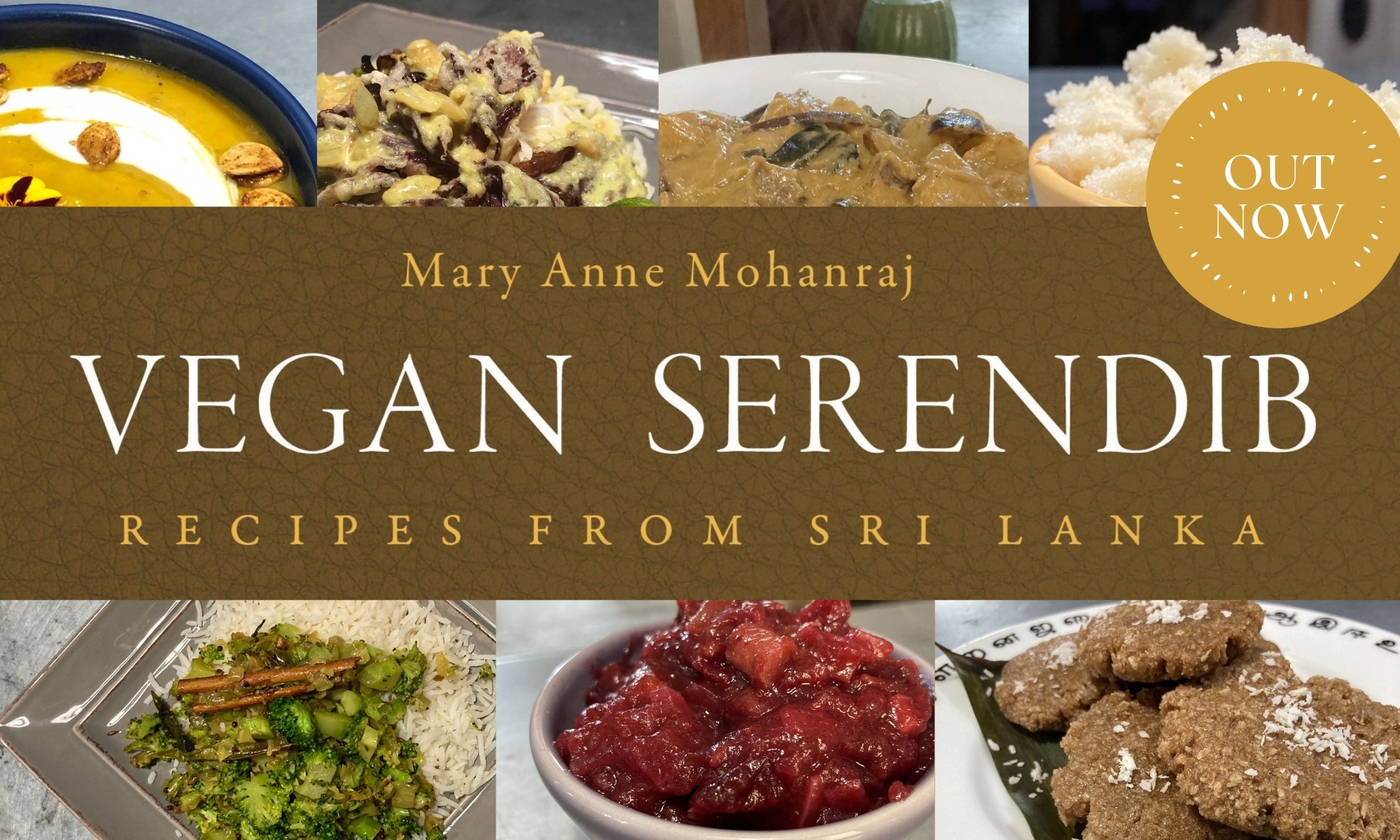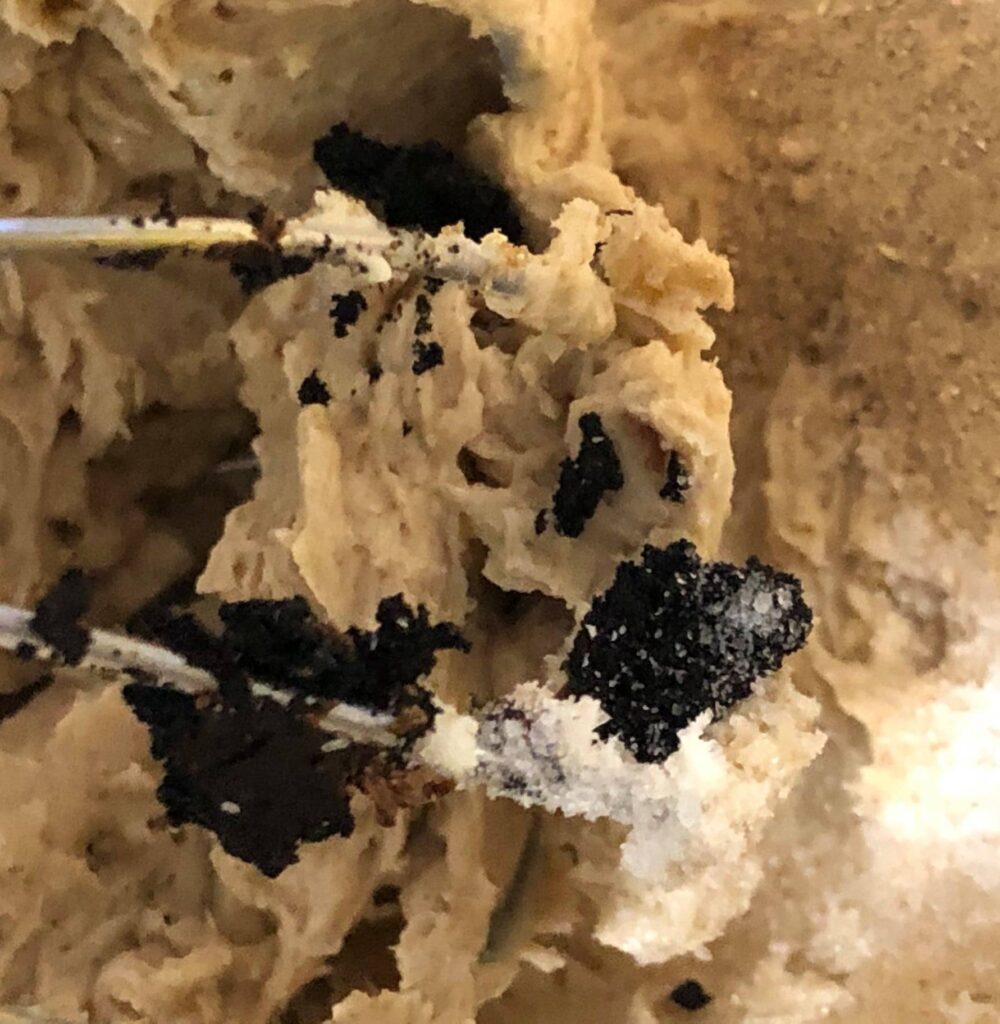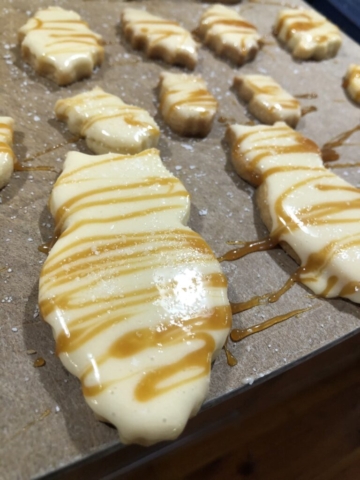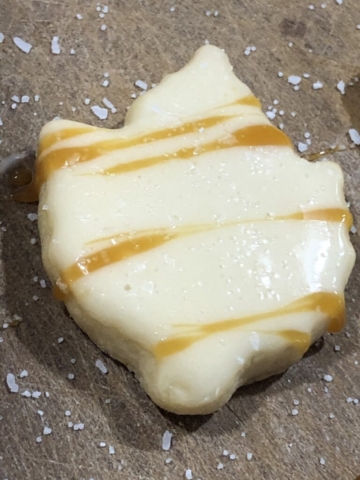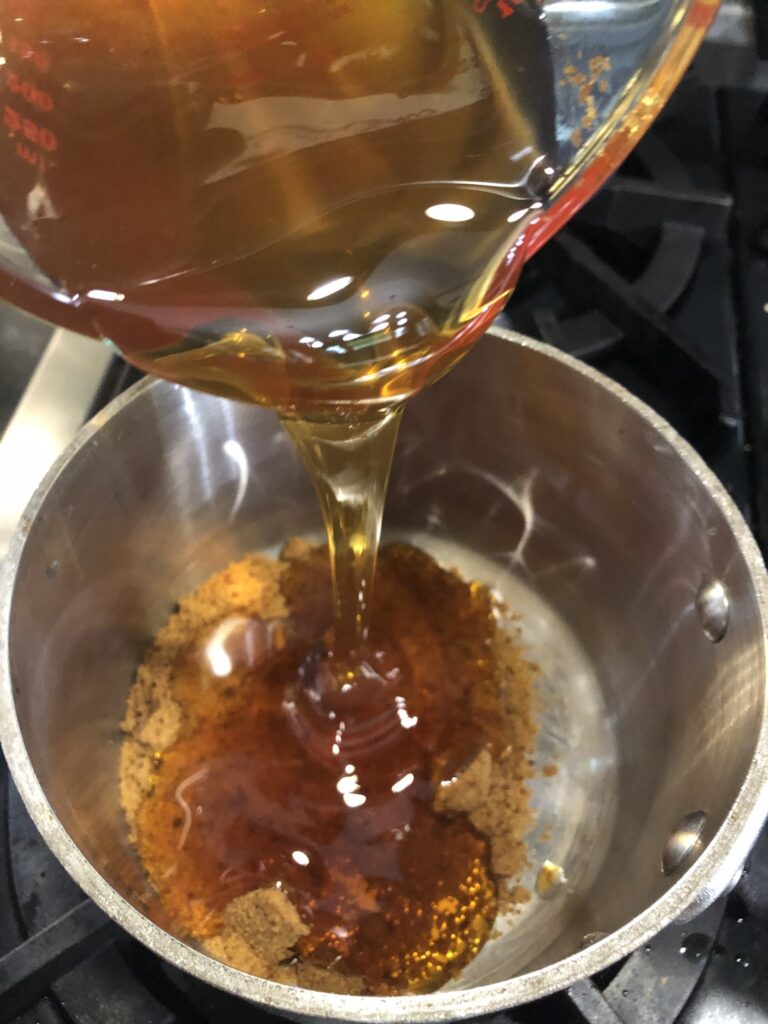Just pretty. Ground pistachio, about to be folded into Pooja Makhijani’s lovely cardamom cake.
Diwali Bundt Cake
I didn’t make this in time for Diwali (had to wait for my new 5-cup bundt pan to arrive), but had a lot of fun making (and eating) it tonight. Pooja Makhijani’s celebration rose, cardamom, and pistachio cake for King Arthur Flour’s site, absolutely perfect with a cup of chai at teatime (or in my case tonight, right before bed). Thanks, Pooja!
(If you don’t have a 5-cup bundt pan, and don’t want an excuse to buy one, she notes that this fits nicely in a loaf pan.)
A Scolding
When I’m in production baking mode, I often enlist Kevin to help out, but I have to be a little careful with instructions. He’s a great cook, but the last time I had him make cookie dough for me, he used vanilla extract instead of beans.
And quality vanilla extract is great, I use it a lot for baking, but there’s something about using the actual beans that just produces a better cookie, I think. I’m not enough of a food expert to tell you why, though!
I scolded him; he won’t do that again. ![]()
(I get both my extract and beans from Penzey’s. Pricey, but SO good.)
Feels Desi to Me
Dark chocolate-dipped cardamom, rose & vanilla shortbread (see previous post for recipe). I think I love the gold leaf + dried rose petal decorations the best; they feel very desi to me.
But the gold polka dots are also cute on a sweater, and the white hearts, and the tiny pink dots make me think of cute little kids, so okay, I like them all. Luckily, I don’t have to pick. ![]()
Cardamom & Rose Shortbread
Dipping and decorating some of the cardamom, rose & vanilla shortbread from the weekend (for the Patreon treat boxes). Honestly, I think I like these cookies best plain myself, but it’s fun to play with decorating, and rarely does anyone complain about a little more chocolate. ![]()
Also, the embossing rollers are pretty hard to use completely evenly, so if there are some cookies that didn’t come out quite perfect, a little chocolate covers a multitude of sins.
*****
(45 minutes + optional 15 minutes chilling time)
Gorgeously aromatic, these warm flavors make for a perfect chai companion.
Ingredients:
dried rose petals and edible gold flakes for decorating, optional
1. Preheat the oven to 350F.
2. Cream together the butter and sugar; add the vanilla, rose, salt, and cardamom. Then add flour and mix on low until dough forms.
3. Turn out dough onto floured board and shape into a firm ball. (If it’s not coming together into a dough, the heat of your hands will help.) NOTE: Can be kept chilled at this point for several days, covered in plastic wrap, and then rolled, cut, and baked fresh.
4. Firmly pat flat and roll smooth (to desired cookie height, usually about 1/2 inch). If using embossed pattern rollers, roll carefully now. If using cookie cutters, cut out shapes, place on parchment-covered baking sheet, and chill for 15 minutes (to help hold shape).
Alternately, press into baking pan or shortbread mold, prick with fork. You can also cut shapes out after baking — shortbread is very forgiving that way — but then the individual cookie edges won’t be browned.
5. Remove from fridge and bake for 15 to 20 minutes, until the edges begin to brown, then remove to wire rack to cool. Delicious with chai!
6. Optional: Melt chocolate chips in double boiler or glass bowl in microwave at half power. Dip cookies, place on parchment paper, decorate, let dry.
Compote Comfort
I wanted dessert last night, something fruity, but not too rich. I sliced a slightly underripe pear and a few similarly underripe figs, then sautéed them for a few minutes in butter. Added a drizzle of bourbon maple syrup, and it was done. Moderately healthy, for a dessert, since it’s mostly fruit, and delicious.
Battenberg Tempted
I really was tempted to make a Battenberg cake for Anand’s 11th birthday after the season premiere of GBBO featured them, but there were a few problems with that plan:
a) I suspected he wouldn’t like the traditional marzipan icing. Honestly, I don’t particularly like marzipan icing — I can handle a little of it on Sri Lankan fruit cake at weddings, but it doesn’t excite me.
b) I didn’t think he’d like the jam used to adhere the layers — we had a very nice birthday cake earlier this summer with jam between the layers and he scraped it all off. Why my children don’t like jam, when they love fruit and sugar, I really don’t know. But anyway. Kavi was worried that I might put jam in her brother’s cake, and I assured her that I would not. (I love jam in cake. Sigh.)
c) Most of the Battenberg cake recipes I looked at also incorporated ground almond in the cake mix, and I wasn’t sure he’d like that flavor either. It would be sad to make him a birthday cake he didn’t like, and while he could scrape off marzipan and jam, he couldn’t scrap the ground almond out of the cake! So that seemed right out.
But in researching, people mentioned checkerboard cakes, and it looked like it was basically the same concept, with regular cake (no ground almond), frosting instead of jam to adhere the layers, and more frosting on the outside. Perfect.
I told Anand I was thinking of making him a two flavor cake, and I knew he wanted chocolate for one of the flavors. I offered him a choice of vanilla, raspberry, strawberry, apple, or mango for the other flavor, and he went for vanilla. Not what I would’ve picked, but hey, it’s his cake.
The next step was making decisions about pans and cutting. Most recipes for checkerboard cake call for 4 9″ cake pans. I have only 1 of those, and the prospect of using it 4 times seemed a bit much.
I might’ve done it, but they also called for 6″ and 3″ cookie cutters (or sometimes 5 1/2″ and 2 1/2″), and I don’t have any cutters bigger than 5″. I didn’t want to buy specialty items just for this cake, so I reluctantly abandoned that plan. (It does look quite a bit simpler than I what I did, and more likely to hold together well, so I’d recommend looking for those if you’re going to try it.)
Instead, I used a rectangular cake pan (of which I only had one). I used this recipe for the cake mix, baking half of it as a yellow cake, and then adding cocoa and baking half as a chocolate cake. (My halves weren’t quite even, so I ended up cutting off some excess chocolate cake. Hey, they do that in GBBO all the time. I think it’s legit.)
https://www.foodnetwork.com/…/chocolate-and-vanilla…
I didn’t use her frosting recipe, mostly because I didn’t have any heavy cream on hand, and just made a classic buttercream instead, which is really what I like best anyway. (Passionfruit buttercream is to DIE for.)
Then it really was pretty simple — just cutting it up and alternating layers to make the checkerboard lines. I did a lot more little squares than most such cakes, which gives a pretty fun result — the kids at the birthday party were mildly impressed.
But that many squares also makes the cake a little less structurally sound, especially since the classic cake batter yielded a pretty soft cake. I suspect Battenberg, with the ground almond, has a slightly more cohesive result that’s a little easier to work with (and jam is easier to spread than frosting).
I didn’t try to frost vertically between layers, just horizontally, and that held it together BARELY enough. More frosting on top and sides — I’m not very good at that, and definitely didn’t have the energy to try piping, but sprinkles cover a multitude of sins.
Overall, pretty easy, honestly, and would do again if someone wanted one, though I might make them buy me a large cookie cutter and at least one more 9″ cake pan first. I still kind of want to try the Battenberg someday, but I think it’d probably have to be for a more grown-up event. ![]()
Fingers Crossed
This Worked Very Nicely
Mulled Apple Cider, Honey, & Jaggery Marshmallows
Cider marshmallow experiments. I made my mulled apple cider marshmallows with corn syrup and white sugar first, per usual, but for the second batch, I tried swapping those ingredients for honey and jaggery.
The honey makes the syrup boil up much higher, so you do need to use a bigger pot, or be extra careful watching the temp, or you’re likely to have it boil over. And the honey/jaggery version gave a stickier marshmallow, needing to be tossed in powdered sugar a second time. But I like this version better, with more complexity to the flavors.
I would still like a little more brightness of apple; the mulling concentrates and changes the flavor. Maybe adding a little apple extract next time? Hmm…
4 c. apple cider
4 sticks cinnamon
12 cloves
3 packages unflavored gelatin
1 c. jaggery (or dark brown sugar)
1/2 c. honey
1/4 teaspoon salt
butter (for greasing the pan)
cinnamon powder for dusting (a few T)
powdered (confectioner’s) sugar (about 1/2 c.)
- MAKE MULLED CIDER: In a small pot on the stove, heat cider with cinnamon and cloves. Bring to a boil, turn down to a simmer, and simmer 10 minutes or so. Remove 1 c. for marshmallows, sieving out any whole spices; drink whatever remains. (Can be done in advance.) If you simmer for longer, the flavor concentrates more; you can simmer it all the way down to 1 c. if you like, but it’ll take quite a long time.
- Empty gelatin packets into bowl of stand mixer (whisk attachment), with 1/2 c. of the mulled cider. Stir briefly to combine.
- In a small saucepan (a bigger one will be heavy and hard to hold steadily at a later stage) combine the other 1/2 c. of mulled cider, jaggery, honey, and salt. Cover and cook over medium high heat for 4 minutes. Uncover and cook until the mixture reaches soft ball stage (240 degrees if you have a candy thermometer), approximately 8 minutes. Once the mixture reaches this temperature, immediately remove from heat; if it continues, it will swiftly turn into hard candy.
- Turn mixer on low speed and, while running, slowly pour the sugar syrup down the side of the bowl into the gelatin mixture. (Be very careful with the sugar syrup, as it is scaldingly hot and will burn you badly if it gets on your skin.) Once you’ve added all of the syrup, increase the speed to high.
- Continue to whip until the mixture becomes very thick and is lukewarm, approximately 12 minutes. Add food color if desired.
- While it’s whipping, butter a large 9 x 12 pan. Prepare an oiled spatula. Pour the mixture into the prepared pan, spreading it evenly (and swiftly) with the oiled spatula.
- Sprinkle with ground cinnamon and dust the top with enough of the powdered sugar to lightly cover. Reserve the rest of the powdered sugar for later. Allow the marshmallows to sit uncovered for at least 4 hours and up to overnight.
- Turn onto a board, cut into squares, and dust all sides of each marshmallow with the remaining powdered sugar, using additional if necessary. May be stored in an airtight container for up to 3 weeks, or frozen.
